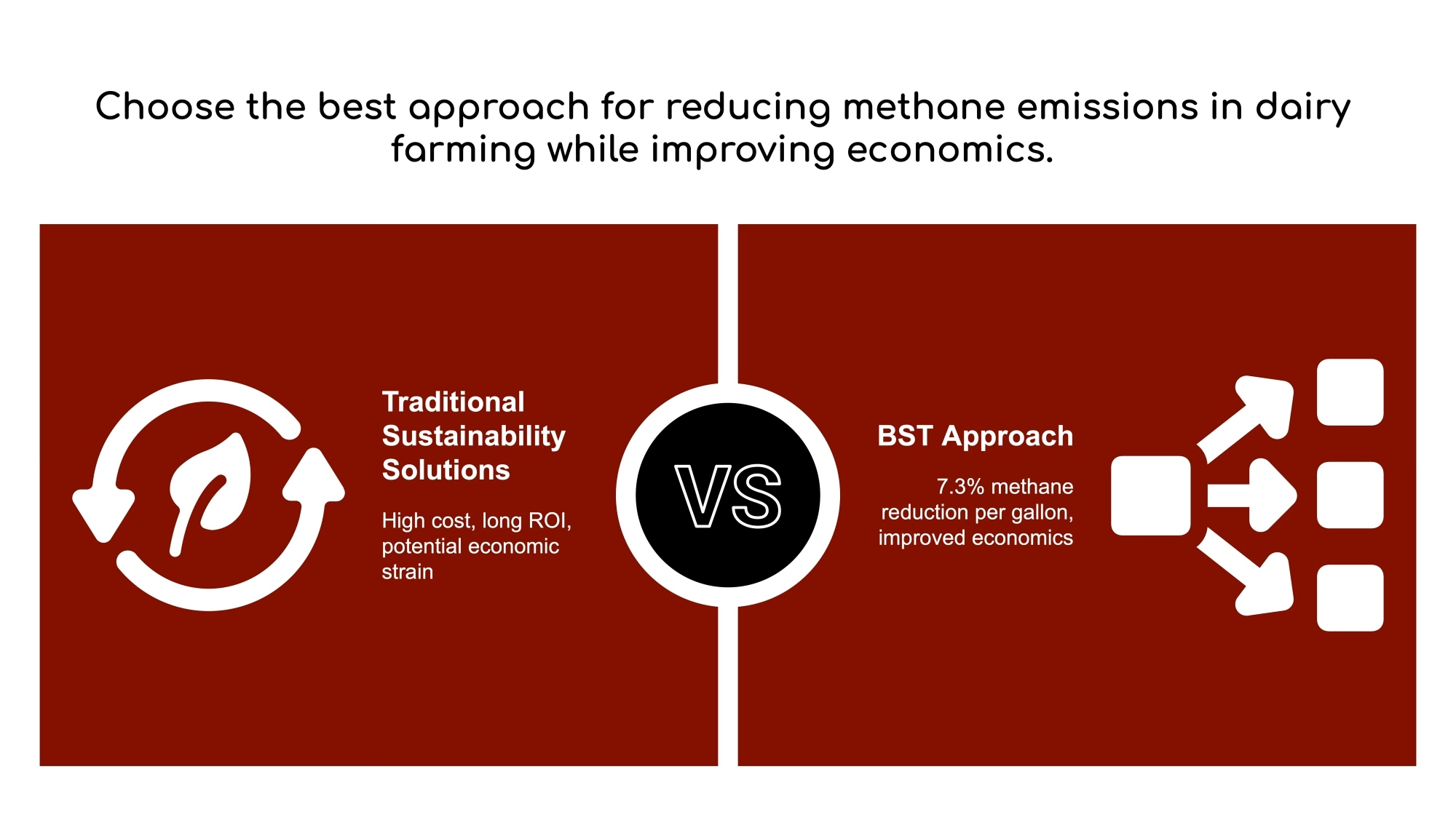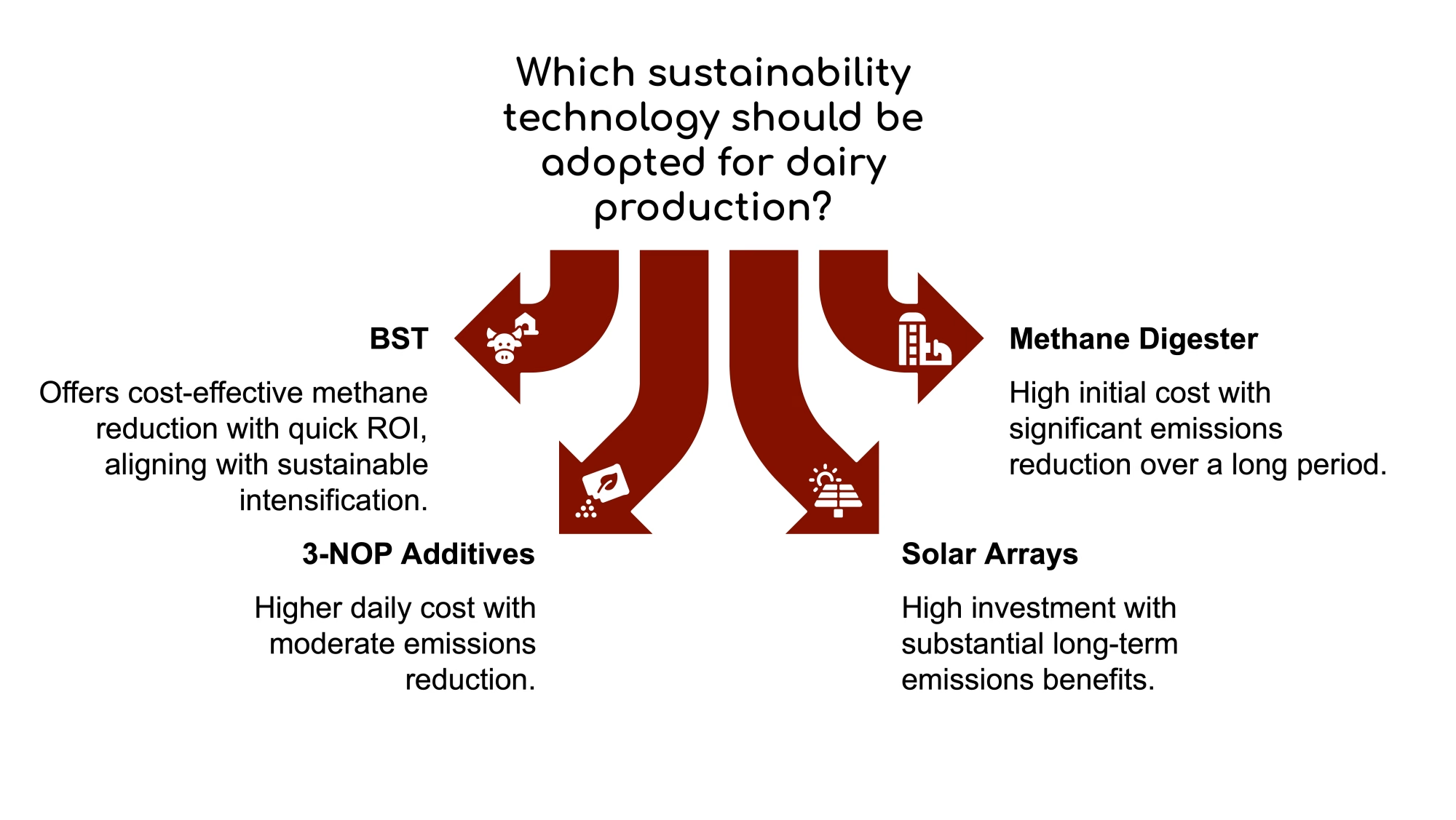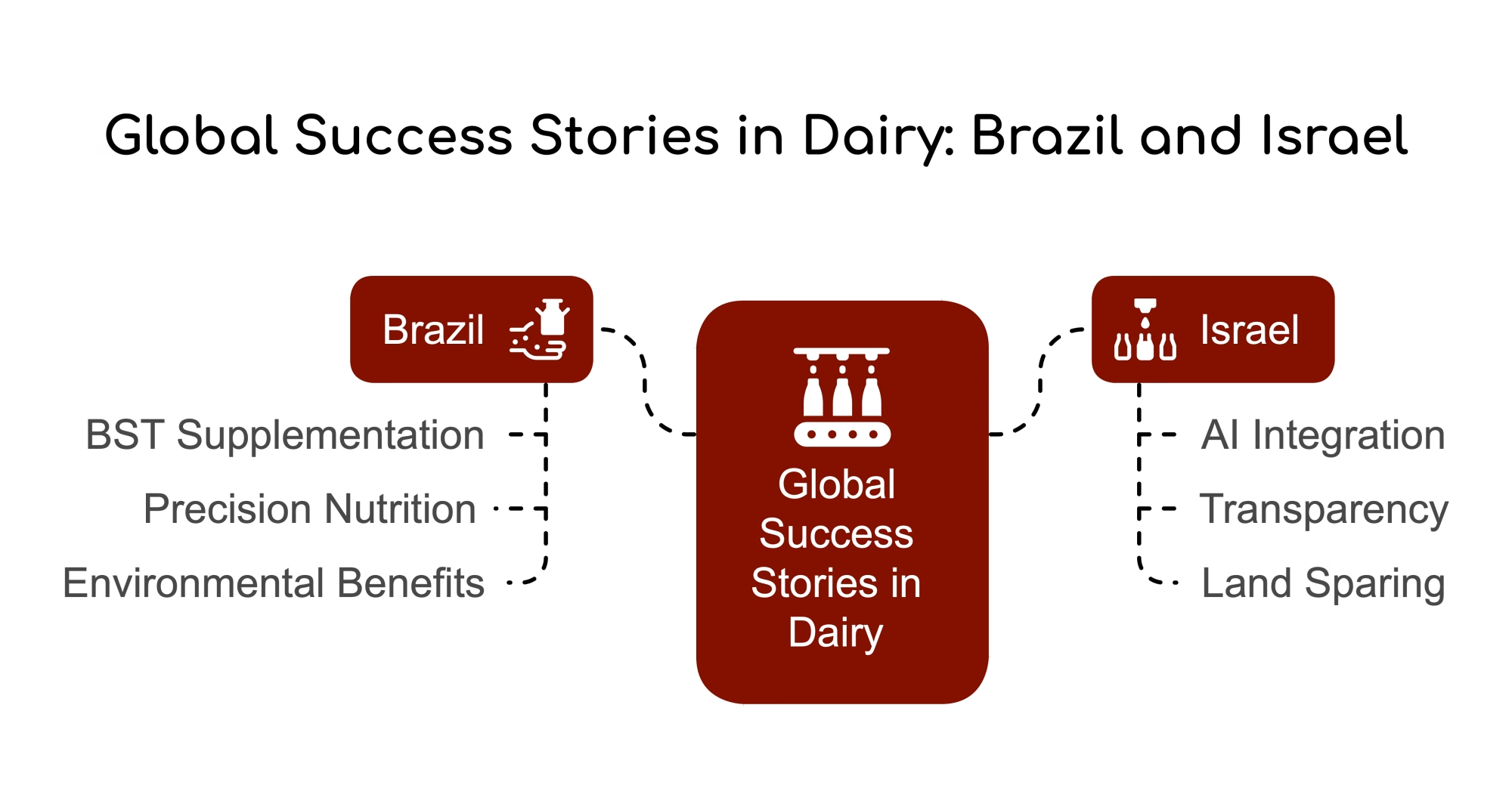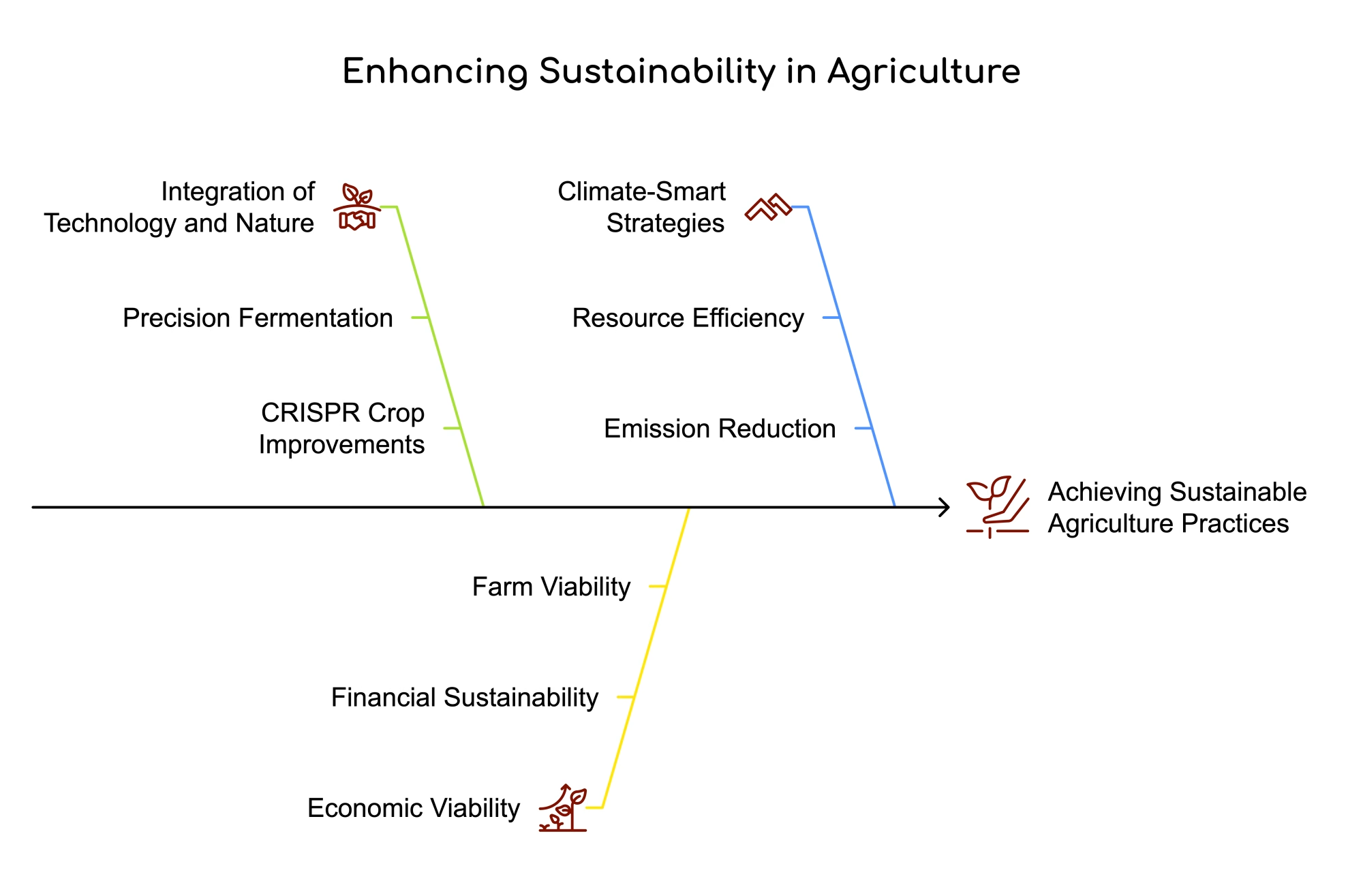BST: Dairy’s Controversial Climate Hero? Discover how this taboo tech slashes emissions and boosts efficiency—plus why the industry’s sustainability future hinges on embracing it.
The future of dairy farming is facing a critical moment. The industry stands at a crossroads between environmental demands and economic survival. Bovine somatotropin (BST), an overlooked solution for decades, could significantly improve sustainability metrics while keeping farms profitable. Let’s examine why this technology deserves a second look in today’s climate-conscious world.
The Sustainability Trap: How Regulators Set You Up to Fail

The numbers tell a sobering story. Dairy contributes approximately 2% of U.S. greenhouse gas emissions, primarily methane—a greenhouse gas 25 times more potent than carbon dioxide. With global climate agreements pushing for net-zero emissions by 2050, dairy farmers face mounting pressure to reduce their environmental footprint.
I recently spoke with a third-generation dairy farmer from Wisconsin who articulated the challenge perfectly: “They want us to hit these ambitious climate targets, but the approved solutions cost more than many of us make in a year.”
He’s not exaggerating. Consider the current sustainability options available to dairy producers:
- Anaerobic digesters: $1.2 million per installation
- Solar arrays: $4,500 per cow equivalent
- Precision feeding systems: $10,000+ for monitoring equipment
- Carbon consultancy services: $450 per hour
Meanwhile, milk prices hover around $20 per hundredweight, creating a nearly impossible economic equation for many family farms. The return on investment for these approved technologies often stretches beyond a decade—assuming the farm survives that long.
What if there were a more efficient approach? What if we could reduce methane emissions by 7.3% per gallon of milk produced while improving farm economics? This is where BST enters the conversation—and why it deserves serious reconsideration.
BST: The Biological Efficiency Hack You’re Missing

Bovine somatotropin isn’t some Frankenstein chemical but a naturally occurring protein hormone that cows produce. The supplemental form (recombinant BST or rBST) is structurally identical to what cows naturally produce.
The science behind BST is fascinating. It works through what researchers call the “dilution of maintenance” effect. Every dairy cow uses approximately 35% of its feed energy to maintain essential bodily functions—breathing, circulation, and temperature regulation—energy not directed toward milk production. BST optimizes this energy partition by directing more nutrients toward milk synthesis. (Read more: Invited Review: Somatotropin and Lactation Biology)
At the cellular level, BST binds to receptors in the mammary gland that signal cells to extend their productive lifespan, effectively prolonging peak lactation by up to 41%. The results are remarkable:
- Maintenance energy requirements drop from 35% to 28% of the total intake
- Feed efficiency improves by 14%—equivalent to getting 1.4 free meals per day
- Milk production increases by 6-15 pounds daily without proportional increases in feed consumption
Many assume BST was banned due to safety concerns, but this isn’t accurate—at least not in the United States. The FDA approved BST in 1993 after a comprehensive 12-year review process. Their conclusion was unequivocal: milk from BST-treated cows is indistinguishable from milk produced by untreated cows.
A combination of early implementation challenges and effective activism sidelined BST. Initial trials in the 1990s showed a temporary 53% increase in mastitis (udder infections) during the adaptation period. This data point became the centerpiece of opposition campaigns, leading to widespread “rBST-free” marketing and retailer boycotts.
What This Means For Your Operation

For a typical 500-cow dairy, implementing BST means:
- Feed cost savings: Approximately $120,000 annually
- Additional milk revenue: Around $59,000 per year
- Net profit margin improvement: 3.5 percentage points (from 8.6% to 12.1%)
These aren’t theoretical numbers—they’re based on real-world implementation data from farms that continued using BST after the marketing backlash. That’s enough to purchase a robotic milker every two years without additional debt.
The Environmental Math Your Carbon Consultant Won’t Show You

The environmental benefits of BST are supported by extensive peer-reviewed research. A comprehensive lifecycle assessment found that BST supplementation results in:
- 8.1% reduction in total feed requirements per kilogram of milk produced
- 7.3% reduction in methane emissions per unit of milk
- 6.8% reduction in manure output per unit of milk
- 9.1% and 11.8% reductions in nitrogen and phosphorus excretion, respectively
- 219,000 fewer hectares needed per million cows—an area larger than New York City
To put these numbers in perspective, if implemented across the entire U.S. dairy herd, the methane reduction alone would be equivalent to removing 1.2 million gasoline-powered vehicles from the road annually. The land spared could grow enough food to feed 5-7 million people.
These metrics are particularly compelling because they represent improvements over both conventional and organic production systems. Consider this comparative analysis from a German study examining environmental impacts across different production methods:
| Metric | Conventional | Organic | BST-Enhanced |
| Methane/gallon | 100% | 112% | 92.7% |
| Land Use/gallon | 100% | 130% | 81.9% |
| Synthetic Fertilizer | 100% | 0% | 84% |
These figures challenge the assumption that organic production is inherently more environmentally friendly. While organic systems eliminate synthetic fertilizers, they typically require more land and generate more methane per unit of production due to:
- Lower productivity requires approximately 25% more cows to produce equivalent milk volumes
- Forage-based diets that can increase enteric methane emissions by about 12% per cow
- Carbon sequestration benefits that offset only about half of the higher emissions from increased herd sizes
The “Natural” Myth That’s Costing You Money

Let’s be honest: there’s nothing “natural” about modern dairy production. We’ve been selectively breeding cows for centuries to produce far more milk than their wild ancestors. We synchronize breeding with hormones, manipulate lighting to affect production cycles and feed carefully formulated rations designed by nutritionists.
So why do we draw an arbitrary line at BST?
The truth is, BST offers a different approach—optimizing biological efficiency to produce more milk with fewer resources and lower emissions. This solution aligns perfectly with the concept of sustainable intensification: producing more with less environmental impact.
When comparing BST to other sustainability technologies, the economic advantage becomes even more explicit:
| Technology | Cost/Cow | ROI Horizon | Emissions Reduction |
| BST | $0.47/day | 6 months | 7.3% methane |
| Methane Digester | $1,200 | 11 years | 12% |
| 3-NOP Additives | $2.10/day | 1 year | 11% |
| Solar Arrays | $4,500 | 8 years | 15% |
BST delivers nearly two-thirds of the methane reduction of much more expensive technologies while paying for itself in just six months. Even the widely praised 3-NOP feed additives cost 4.4 times more per cow daily with only marginally better emissions reductions.
These economics matter tremendously for an industry operating on thin margins. BST represents a rare win-win: environmental improvement that strengthens rather than undermines farm viability.
“But What About the Cows?” The Welfare Question You Should Be Asking

Animal welfare concerns have been central to BST opposition, so examining what current research indicates is essential. The picture that emerges from countries where BST remains in use challenges many common assumptions.
Longevity data from Israeli dairy operations show BST-treated herds averaging 3.2 lactations per cow compared to 2.9 in European organic systems and 2.8 in conventional U.S. operations. This suggests that when properly managed, BST does not reduce productive lifespan—it may actually extend it.
Dutch researchers studying herds using BST analogs documented something unexpected: treated cows exhibited 14.3% higher play behavior scores and more frequent interaction with enrichment devices. The biological explanation makes sense—BST helps cows maintain a more stable metabolism by optimizing energy utilization, potentially reducing physiological stress.
Modern BST implementation protocols have addressed many early concerns through:
- Advanced teat sealants ($45/cow/month) that prevent mastitis infections
- Automated health monitoring systems that detect early signs of discomfort
- High-RUP (rumen-undegraded protein) diets that support immune function
- Adjusted dosing schedules that prevent metabolic stress
A veterinarian with experience across both BST and non-BST herds summarized it well: “The presence or absence of BST isn’t what determines cow welfare—it’s the overall management system. A well-managed BST herd consistently outperforms a poorly managed conventional or organic operation in welfare metrics.”
This perspective aligns with Positive Animal Welfare (PAW), which focuses on providing animals with opportunities for positive experiences rather than simply avoiding negative ones. BST’s ability to optimize metabolism supports PAW goals by allowing cows to allocate more energy to immune function and natural behaviors.
Global Success Stories: What Brazil and Israel Know That We Don’t

While North America debates BST, several countries have continued using it with impressive results. Their experiences offer valuable insights into practical implementation strategies.
Brazil: Combining BST with Precision Nutrition
Brazilian dairy operations in Minas Gerais have developed a model that pairs BST with high-RUP diets (18% rumen-undegraded protein), achieving remarkable results:
- Milk yield: 9,450 kg per lactation (15.2% above conventional systems)
- Methane intensity: 0.38 kg per kg milk (15.5% below traditional systems)
- Profitability: $3,400 per hectare (62% higher than conventional operations)
Their approach includes BST supplementation every 14 days and precision feeding to maximize efficiency. Real-time methane monitoring during milking provides continuous verification of environmental benefits.
A farm manager from São Paulo explained their philosophy: “We’re not choosing between environmental performance and economics—we’re optimizing both simultaneously. BST is the tool that makes this possible.”
Israel: Integrating BST with Advanced Technology
Israeli kibbutz dairies have taken integration further, combining BST with artificial intelligence and sensor technologies. Their comprehensive monitoring systems track:
- Methane emissions (287 ppm per eructation versus 312 ppm in non-BST herds)
- Feed efficiency (21.4 kg milk/cow/day—37% above European averages)
- Behavioral indicators of welfare and comfort
What’s particularly noteworthy is their approach to transparency. Rather than concealing BST use, they highlight it through QR-coded labels that allow consumers to access real-time emissions data. Their messaging focuses on “Climate-Smart Dairy” rather than production technology.
The economic results speak for themselves: robot milker ROI in 3.1 years versus 4.7 years without BST, and land sparing of 219 hectares per 1,000 cows—land they’ve repurposed for biodiversity initiatives, including pollinator habitats.
The Regulatory Absurdity Hurting Your Bottom Line

The regulatory history of BST varies significantly by region. Canada banned BST in 1999, citing cow welfare concerns rather than human safety issues. The European Union followed with similar restrictions. The United States never formally banned BST, but market pressures have achieved nearly the same effect.
This regulatory divergence has created some paradoxical situations. Canada, for instance, now imports U.S. dairy products that may come from BST-treated herds while simultaneously preventing its own farmers from using the technology. Meanwhile, it faces potential losses of $2.1 billion if herd reductions become necessary to meet climate targets.
In the U.S., state-level approaches to BST labeling have varied considerably. Ohio attempted to restrict “rBST-free” labels in 2008, arguing they mislead consumers by implying safety differences. Pennsylvania took a more moderate approach, allowing such labels but requiring the disclaimer: “No significant difference has been shown between milk derived from rBST-treated and non-rBST-treated cows.”
The scientific consensus from regulatory bodies worldwide remains consistent:
- The FDA, after extensive review, found “no biologically meaningful differences” in milk from BST-treated cows
- The World Health Organization concluded BST “does not present a hazard to human health.”
- The American Medical Association supports the safety of dairy products from BST-supplemented cows
As climate regulations tighten across North America, there’s an opportunity to revisit BST regulations through an environmental lens. The technology’s documented benefits in reducing greenhouse gas emissions, land use, and resource consumption align perfectly with current sustainability priorities.
Your Five-Step Plan to Implement BST Successfully

What would it take to reintegrate BST into your dairy operation? Based on successful international models, here’s a comprehensive approach:
1. Update Your Protocols
- Implement current best practices: 500mg/100kg body weight every 14 days
- Pair with high-RUP diets to maximize methane reduction potential (up to 12.7%)
- Integrate with monitoring technologies to ensure optimal welfare outcomes
2. Build Transparency Into Your Brand
- Develop “Climate-Smart Dairy” certification highlighting verified emissions reductions
- Implement QR code systems allowing consumers to access real-time environmental data
- Establish third-party verification of welfare outcomes in your BST-utilizing herd
3. Create Industry Alliances
- Form implementation working groups to gather North American-specific data
- Partner with complementary technology providers (robotic milking systems show 41% faster ROI with BST)
- Engage with carbon markets to monetize methane reductions
4. Prepare for Regulatory Engagement
- Document your environmental performance improvements
- Challenge labeling restrictions on ecological grounds
- Propose phased implementation beginning with climate-vulnerable regions
5. Communicate Benefits Effectively
- Shift terminology from “growth hormone” to “metabolic optimizer”
- Focus messaging on environmental benefits rather than production increases
- Position BST as a climate solution rather than a productivity technology
This approach acknowledges the scientific case for BST and the importance of consumer confidence. It addresses the primary concerns that sidelined BST by emphasizing transparency and environmental benefits.
Why This Matters Beyond Your Farm Gate

The BST conversation extends beyond dairy farming—it reflects how we approach the intersection of technology, sustainability, and food production more broadly. Three key considerations make this discussion particularly relevant:
1. The False Dichotomy of “Natural vs. Technological”
We often frame agricultural choices as binary: natural or technological, traditional or modern. BST challenges this dichotomy by optimizing a biological process that already exists. It’s not about replacing nature but working with it more efficiently.
This perspective applies to many sustainability challenges. The most effective solutions often combine biological understanding with technological application—precision fermentation, CRISPR crop improvements, or optimized animal metabolism.
2. The Economic Reality of Sustainability
Environmental improvements that bankrupt farmers aren’t sustainable in any meaningful sense. Climate solutions must be economically viable for them to succeed. BST represents a rare case where environmental benefits align with economic advantages.
As one dairy economist noted, “We can’t expect farmers to implement practices that put them out of business in the name of sustainability. The solutions that will scale strengthen rather than undermine farm viability.”
3. The Urgency of Climate-Smart Agriculture
With global food demand projected to increase 50% by 2050 while climate change threatens agricultural productivity, we need all available tools to produce more with less environmental impact. BST’s documented benefits in reducing resource use and emissions make it a valuable component of climate-smart agriculture.
The metrics are compelling: 7.3% less methane, 8.1% less feed, and 219,000 hectares spared per million cows. Multiplied across global dairy production, these improvements could significantly contribute to agricultural climate goals.
The Bottom Line: Act Now or Get Left Behind
The dairy industry faces unprecedented challenges: tightening environmental regulations, changing consumer expectations, and economic pressures threatening multi-generational family farms. Meeting these challenges requires innovation and a willingness to reconsider past decisions in light of new information.
BST represents a scientifically validated tool that could help your operation navigate this complex landscape. Its documented benefits in reducing environmental impact while improving economic outcomes make it worthy of serious reconsideration.
The path forward isn’t about returning to the past but applying what we’ve learned over three decades to implement BST more effectively. Modern protocols, advanced monitoring, and transparent communication can address the legitimate concerns that emerged during early adoption.
For dairy farmers caught between sustainability mandates and economic survival, BST offers a potential lifeline—a way to reduce environmental impact while maintaining viability. For consumers concerned about planetary health and local food systems, it presents an opportunity to support truly sustainable production.
As we look toward a net-zero future for dairy, let’s ensure that science rather than perception guides our decisions. The stakes—for farmers, rural communities, and our climate—are too high for anything less.
What’s your next move? Will you continue investing in expensive technologies with decade-long payback periods, or is it time to reconsider BST as part of your sustainability strategy? The choice is yours, but the clock is ticking on both climate targets and farm profitability.
Key Takeaways
- Climate Impact: BST cuts emissions equivalent to 400,000 cars annually when used on 1 million cows.
- Farm-Level Gains: Producers like Mike Peterson report $73k/year savings and improved herd health with proper management.
- Regulatory Shifts: Canada and Walmart now embrace BST for emissions reduction, while the EU faces mounting pressure to reconsider bans.
- Tech Synergy: Pairing BST with seaweed feed or AI collars maximizes efficiency and minimizes environmental footprint.
- Consumer Dilemma: 68% demand “BST-free” milk, yet most can’t define the term—highlighting a gap between perception and science.
Executive Summary
BST—a hormone supplement vilified for decades—emerges as a potent climate tool for dairy. Research reveals it cuts emissions by 7.5% per gallon, reduces land use by 9%, and saves water by 10% when scaled. Real-world farms like Wisconsin’s Peterson operation prove it: fewer cows, higher profits, and healthier herds. Yet, debates rage—organic advocates argue for “natural” methods, while regulators and brands like Walmart now back BST for meeting climate targets. Pairing it with methane-reducing feed or AI monitoring amplifies benefits, but adoption hinges on balancing efficiency, welfare, and consumer trust. The verdict? BST isn’t a silver bullet but a critical lever in dairy’s sustainability arsenal.
Read more:
- Beyond BST: Cutting-Edge Feed Additives That Slash Dairy’s Methane Footprint
Explore how seaweed-based supplements and 3-NOP are revolutionizing emission reductions—without hormone controversies. - The Genomics Revolution: Breeding Cows for Climate Resilience and Milk Efficiency
Discover how genetic selection is creating herds that thrive in warming climates while boosting output per cow. - Navigating the “Natural” Label: How Dairy Farmers Can Bridge the Perception-Reality Gap
Actionable strategies for communicating sustainable practices to skeptical consumers and retailers.
 Join the Revolution!
Join the Revolution!
Join over 30,000 successful dairy professionals who rely on Bullvine Daily for their competitive edge. Delivered directly to your inbox each week, our exclusive industry insights help you make smarter decisions while saving precious hours every week. Never miss critical updates on milk production trends, breakthrough technologies, and profit-boosting strategies that top producers are already implementing. Subscribe now to transform your dairy operation’s efficiency and profitability—your future success is just one click away.








 Join the Revolution!
Join the Revolution!








